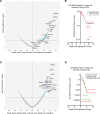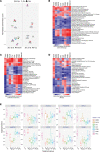Fetal maturation revealed by amniotic fluid cell-free transcriptome in rhesus macaques
- PMID: 35980752
- PMCID: PMC9675452
- DOI: 10.1172/jci.insight.162101
Fetal maturation revealed by amniotic fluid cell-free transcriptome in rhesus macaques
Abstract
Accurate estimate of fetal maturity could provide individualized guidance for delivery of complicated pregnancies. However, current methods are invasive, have low accuracy, and are limited to fetal lung maturation. To identify diagnostic gestational biomarkers, we performed transcriptomic profiling of lung and brain, as well as cell-free RNA from amniotic fluid of preterm and term rhesus macaque fetuses. These data identify potentially new and prior-associated gestational age differences in distinct lung and neuronal cell populations when compared with existing single-cell and bulk RNA-Seq data. Comparative analyses found hundreds of genes coincidently induced in lung and amniotic fluid, along with dozens in brain and amniotic fluid. These data enable creation of computational models that accurately predict lung compliance from amniotic fluid and lung transcriptome of preterm fetuses treated with antenatal corticosteroids. Importantly, antenatal steroids induced off-target gene expression changes in the brain, impinging upon synaptic transmission and neuronal and glial maturation, as this could have long-term consequences on brain development. Cell-free RNA in amniotic fluid may provide a substrate of global fetal maturation markers for personalized management of at-risk pregnancies.
Keywords: Bioinformatics; Obstetrics/gynecology; Reproductive Biology.
Figures






Similar articles
-
Global gene expression changes of amniotic fluid cell free RNA according to fetal development.Eur J Obstet Gynecol Reprod Biol. 2017 Sep;216:104-110. doi: 10.1016/j.ejogrb.2017.07.017. Epub 2017 Jul 15. Eur J Obstet Gynecol Reprod Biol. 2017. PMID: 28750298
-
RNA-Seq of amniotic fluid cell-free RNA: a discovery phase study of the pathophysiology of congenital cytomegalovirus infection.Am J Obstet Gynecol. 2022 Oct;227(4):634.e1-634.e12. doi: 10.1016/j.ajog.2022.05.035. Epub 2022 May 21. Am J Obstet Gynecol. 2022. PMID: 35609640 Free PMC article.
-
Systems biology evaluation of cell-free amniotic fluid transcriptome of term and preterm infants to detect fetal maturity.BMC Med Genomics. 2015 Oct 22;8:67. doi: 10.1186/s12920-015-0138-5. BMC Med Genomics. 2015. PMID: 26493725 Free PMC article.
-
The Amniotic Fluid Cell-Free Transcriptome Provides Novel Information about Fetal Development and Placental Cellular Dynamics.Int J Mol Sci. 2021 Mar 5;22(5):2612. doi: 10.3390/ijms22052612. Int J Mol Sci. 2021. PMID: 33807645 Free PMC article. Review.
-
Amniotic fluid: the use of high-dimensional biology to understand fetal well-being.Reprod Sci. 2014 Jan;21(1):6-19. doi: 10.1177/1933719113485292. Epub 2013 Apr 18. Reprod Sci. 2014. PMID: 23599373 Free PMC article. Review.
Cited by
-
Decoding bioactive signals of the RNA secretome: the cell-free messenger RNA catalogue.Expert Rev Mol Med. 2024 Apr 29;26:e12. doi: 10.1017/erm.2024.12. Expert Rev Mol Med. 2024. PMID: 38682644 Free PMC article. Review.
References
-
- Geary CWJ. In: Spitzer AR, ed. Amniotic fluid markers of fetal maturity. Intensive Care of the Fetus and Neonate. Elsevier-Mosby; 2005:1440.

